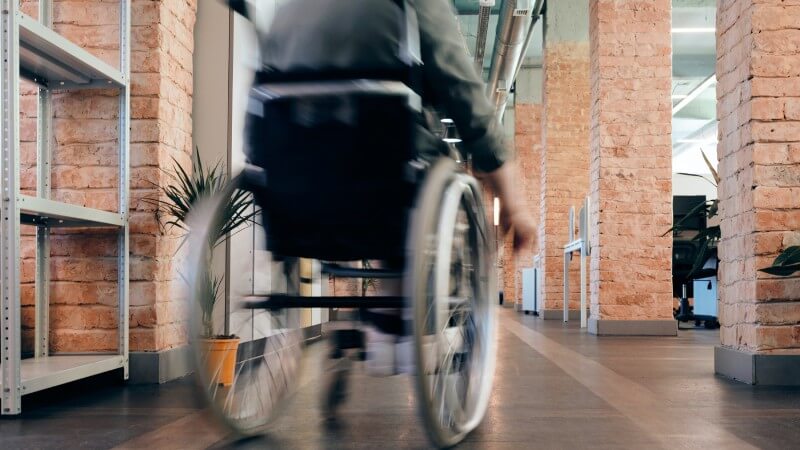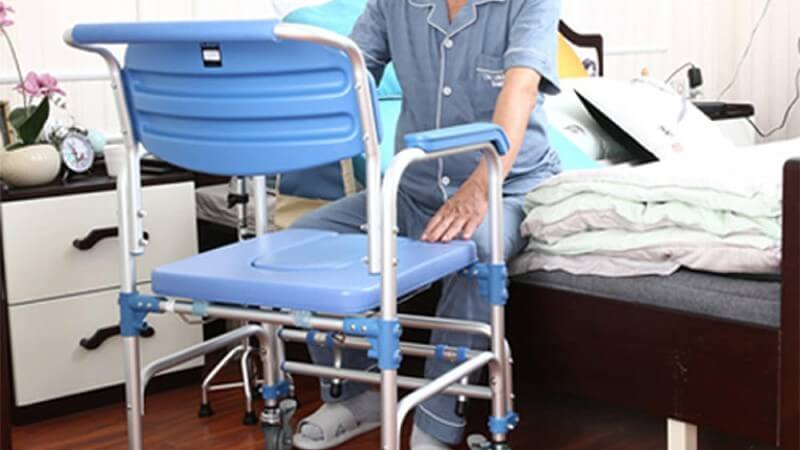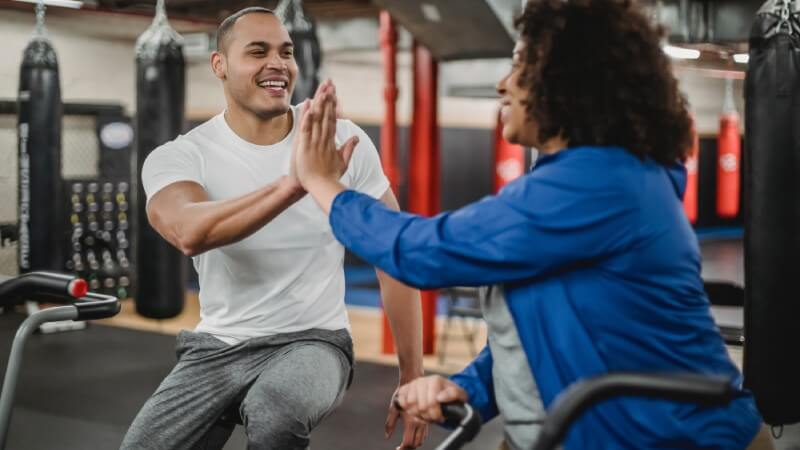Exercises For Seniors in Wheelchairs
For seniors who use wheelchairs, maintaining physical activity is crucial for overall health and well-being. While mobility challenges can limit certain exercises, numerous effective and safe workouts are tailored specifically for those in wheelchairs.
Whether you’re looking for a simple stretching routine, heart-pumping cardio exercises, or leisurely activities, there’s something that can fit into your daily schedule.

The Importance of Exercise for Wheelchair Users
Exercise is universally recognized as a cornerstone of good health. However, for wheelchair users, the significance of maintaining an active lifestyle takes on added dimensions.
Here’s a deeper dive into the importance of exercise for those who rely on wheelchairs:
Physical Health and Muscle Maintenance:

- Upper Body Strength: Wheelchair users predominantly rely on their upper body for mobility and daily tasks. Regular exercise ensures that the arms, shoulders, and back remain strong, making it easier to propel the wheelchair, transfer to and from the chair, and carry out daily activities.
- Prevention of Secondary Health Issues: Lack of mobility can lead to various health complications like cardiovascular diseases, diabetes, and obesity. Engaging in regular exercise helps mitigate these risks.
- Bone Density: Weight-bearing exercises can help in maintaining bone density, reducing the risk of fractures, which can be a concern for many wheelchair users.
Mental and Emotional Well-being

- Endorphin Release: Physical activity stimulates the release of endorphins, the body’s natural painkillers and mood elevators. This can be especially beneficial for wheelchair users who might experience chronic pain or discomfort.
- Combatting Isolation: Engaging in group exercises or sports can provide social interaction, combating feelings of isolation or loneliness that some wheelchair users might experience.
- Boosting Self-esteem: Achieving fitness goals and maintaining an active lifestyle can provide a sense of accomplishment and boost self-confidence.
Enhanced Mobility and Independence:

- Improved Wheelchair Maneuverability: Stronger muscles improve the ability to maneuver the wheelchair in various terrains, enhancing independence.
- Flexibility: Stretching exercises can prevent muscle shortening and joint contractures, ensuring maximum functional mobility.
- Stamina: Cardiovascular exercises improve endurance, allowing wheelchair users to engage in prolonged activities without getting fatigued quickly.
Prevention of Complications:

- Pressure Sores: Regular movement and shifting of weight can prevent the development of pressure sores, a common concern for those who remain seated for extended periods.
- Joint and Muscle Stiffness: Continuous movement ensures that joints remain flexible, reducing the risk of stiffness or contractures.
- Circulatory Issues: Exercises, especially those that elevate the heart rate, promote better blood circulation, and prevent issues like blood clots or edema.
Wheelchair Exercises for Seniors
Regular exercise can help to improve cardiovascular health, strengthen muscles and bones, reduce the risk of chronic diseases, and improve overall mood and well-being.
If you are a senior in a wheelchair, you can do various exercises to stay fit and healthy. Here is a guide to some of the best exercises for seniors in wheelchairs:
1. Warm-up
Before starting any workout, it is important to warm up your muscles to prevent injury. A good warm-up for wheelchair users includes gentle stretches and light cardio activity.
Here are a few warm-up exercises that you can try:
- Arm circles: Sit up straight in your wheelchair and raise your arms out to the sides. Make small circles with your arms, gradually increasing the size of the circles as you warm up.
- Neck rolls: Slowly roll your head from side to side and front to back.
- Leg extensions: Sit straight in your wheelchair with your feet flat. Extend one leg out in front of you, keeping your toes pointed. Hold for a few seconds, then return to the starting position and repeat with the other leg.
- Knee lifts: Sit straight in your wheelchair with your feet flat. Lift one knee towards your chest, keeping your thigh parallel to the ground. Hold for a few seconds, then lower your leg back to the starting position and repeat with the other leg.
2. Cardio
Cardiovascular exercise is important for overall health and well-being. It can help to improve heart health, reduce the risk of chronic diseases, and boost energy levels.
There are a number of different ways for wheelchair users to get cardio exercise. Here are a few ideas:
- Wheelchair basketball: Wheelchair basketball is a great way to exercise cardio while having fun. It is a team sport suitable for people of all fitness levels.
- Wheelchair dancing: Wheelchair dancing is another fun and active way to get cardio exercise. There are various wheelchair dance styles, so you can find one you enjoy.
- Handcycling: Handcycling is a great way to get cardio exercise outdoors. It is a low-impact activity that is easy on the joints.
- Swimming: Swimming is another excellent cardio exercise for wheelchair users. It is a low-impact activity that is easy on the muscles and joints.
3. Strength training
Strength training is important for building and maintaining muscle mass. It can also help to improve bone health and reduce the risk of injuries.
There are several different strength training exercises that wheelchair users can do. Here are a few examples:
- Arm exercises: There are various arm exercises that wheelchair users can do using weights, resistance bands, or simply their body weight. Some examples of arm exercises include bicep curls, tricep extensions, and shoulder presses.
- Leg exercises: Wheelchair users can also do various leg exercises to strengthen their muscles. Some leg exercises include knee extensions, hamstring curls, and calf raises.
- Core exercises: Core exercises are important for strengthening the muscles in the abdomen and back. Some examples of core exercises for wheelchair users include crunches, planks, and bird dogs.
4. Cool-down
After your workout, it is important to cool down your muscles to help them recover. A good cool-down for wheelchair users includes gentle stretches and light cardio activity.
Here are a few cool-down exercises that you can try:
- Arm stretches: Reach your arms overhead and stretch your fingers towards the ceiling. Hold for a few seconds, then release. Repeat a few times.
- Neck stretches: Slowly tilt your head from side to side and front to back. Hold each stretch for a few seconds.
- Leg stretches: Sit straight in your wheelchair with your feet flat. Reach down and touch your toes. Hold for a few seconds, then release. Repeat a few times.
- Hamstring stretch: Sit up straight in your wheelchair with your feet flat on the ground. Extend one leg out in front of you, keeping your toes pointed. Bend forward at the waist and reach towards your toes. Hold for a few seconds, then return to the starting position and repeat with the other leg.
Tips for Wheelchair Users New to Exercise
Embarking on an exercise journey as a wheelchair user can be exciting and daunting. Here are some tips to ensure a safe and effective start:

1. Consult a Professional:
Before starting any exercise regimen, it’s essential to consult with a physical therapist or healthcare professional. They can provide guidance tailored to your specific needs and limitations.
2. Start Slowly:
If you’re new to exercise, starting slowly and gradually increasing your intensity is crucial. This approach helps prevent injuries and allows your body to adapt to the new routine.
3. Prioritize Warm-ups and Cool-downs:
Begin each session with a 5-10 minute warm-up to prepare your muscles. Similarly, concludes with a cool-down phase to relax the muscles and improve flexibility.
4. Focus on Posture:
Proper posture is vital. Ensure you’re seated upright in your wheelchair, with your back against the chair and feet flat on the footrests.
5. Incorporate a Mix of Exercises:
Aim for a balanced routine that includes cardiovascular exercises, strength training, and flexibility exercises. This ensures overall fitness and reduces the risk of overworking a particular muscle group.
6. Stay Hydrated:
Drink plenty of water before, during, and after your workout. Proper hydration aids muscle function and recovery.
7. Invest in Appropriate Equipment:
Consider using resistance bands, dumbbells, or specialized equipment for wheelchair users. These tools can enhance your workout and offer more variety.
8. Listen to Your Body:
Stop the exercise and consult a professional if you experience pain (beyond typical muscle soreness) or discomfort. It’s essential to differentiate between the usual strain of a workout and potential injury.
9. Join a Group or Class:
Many fitness centers offer classes specifically designed for wheelchair users. Joining such a class can provide motivation, structure, and a sense of community.
10. Set Realistic Goals:
Set short-term and long-term goals for your fitness journey. Celebrate small achievements along the way, and remember that consistency is key.
11. Stay Informed:
Continuously educate yourself about exercises and techniques. The more you know, the better equipped you’ll be to make informed decisions about your routine.
12. Enjoy the Process:
Exercise should be enjoyable. Find activities you love, whether wheelchair basketball, dancing, or simple strength training. When you enjoy your work, you’re more likely to stick with it.
Remember, every individual’s journey is unique. What works for one person might not work for another. The key is to find what suits you best, stay committed, and enjoy the myriad benefits of an active lifestyle.
FAQs
Can I do wheelchair exercises even if I have limited upper body strength?
Yes, wheelchair exercises can be tailored to all strength levels. It’s essential to start with low-impact exercises and gradually build your strength over time. Specific exercises are designed to help beginners safely develop their upper body strength.
Are there any exercises specifically for improving core stability for wheelchair users?
Absolutely! While many wheelchair exercises focus on the upper body, there are also exercises designed to engage and strengthen the core. Seated pelvic tilts, seated leg lifts, and isometric abdominal holds are a few examples that can enhance core stability.
How often should I engage in wheelchair exercises to see the benefits?
Ideally, you should aim for at least 150 minutes of moderate-intensity aerobic activity or 75 minutes of vigorous-intensity aerobic activity every week, combined with strength training exercises two or more days a week. However, the frequency can vary based on individual goals and health conditions.
Can I perform wheelchair exercises outdoors?
Many wheelchair exercises can be done outdoors, providing a change of scenery and fresh air. For instance, wheelchair sprints, obstacle courses, or even simple stretches can be done in a park or any open space. Just ensure the surface is smooth and safe for wheelchair movement.
Are there any apps or online resources guiding me through wheelchair exercises?
Several apps and online platforms offer guided workouts specifically designed for wheelchair users. These resources often come with video demonstrations, ensuring you perform the exercises correctly and safely. Review reviews and consult a healthcare professional before starting a new online program.
Conclusion
Exercise is a cornerstone of health, regardless of mobility challenges. For seniors in wheelchairs, it’s about finding the right safe and effective exercises.
By incorporating cardiovascular workouts, strength training, and flexibility exercises into their routine, seniors can enjoy many health benefits and improve their quality of life.
